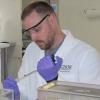new method of iPS could possibly improve integrity of adult stem cells
http://www.scienceda...00415110039.htm
Novel Strategy for Generating Induced Pluripotent Stem Cells for Clinical Use Is Safe and Efficient, Study FindsScienceDaily (Apr. 15, 2010) — A new technique for reprogramming human adult cells could greatly improve the safety and efficiency of producing patient-specific stem cells for use in a range of therapeutic applications to repair or replace damaged or diseased tissues, according to new research.
A description of this innovative strategy is published in the peer-reviewed journal Cellular Reprogramming, published by Mary Ann Liebert, Inc.
Stem cells offer great promise for use in cellular therapy to regenerate specific cell populations in the body. The ability to derive stem cells from a patient's own tissue eliminates the risk that they will stimulate an immune response and be rejected after transplantation.
The process for transforming adult somatic cells into a form of stem cells called induced pluripotent stem (iPS) cells, which are capable of differentiating into all three major cell types, involves reprogramming the cell's genetic contents. This is usually achieved using a virus to introduce multiple (typically four) genetic factors, called transcription factors, into the cells; these would include an oncogene, which carries the risk of cancerous transformation.This new method was applied successfully to reprogram cells from the human gut to form iPS cells, as described in the article. This novel technique required only three transcription factors and no oncogenes. The authors, Yang Li, Hongxi Zhao, Feng Lan, Andrew Lee, Liu Chen, Changsheng Lin, Yuanqing Yao, and Lingsong Li, from Peking University and the Fourth Military Medical University, Tangdu Hospital, in the People's Republic of China, and Stanford University School of Medicine, in Stanford, California, demonstrated the pluripotency of these gut-derived stem cells and their ability to form cell types of all three germ layers.
"These observations are very exciting because they demonstrate that a different cell type can be used when making iPS cells. In addition, Lingsong Li and his colleagues show that Nanog has a key role when reprogramming these cells, whereas it does not with other cell types. This difference provides us with an important new opportunity to study the mechanisms involved in reprogramming," says Professor Sir Ian Wilmut, OBE, FRS, FRSE, Editor-in-Chief of Cellular Reprogramming and director of the MRC Centre for Regenerative Medicine in Edinburgh














































